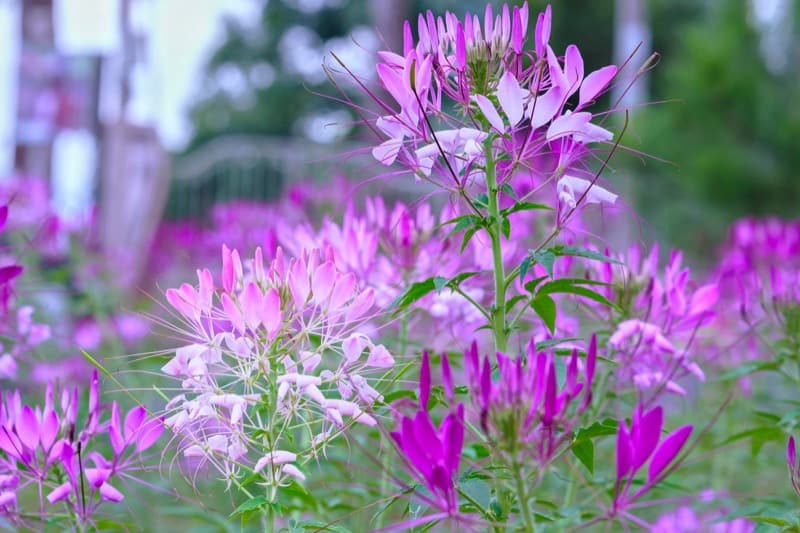The Purple Spider Plant is a sweet smelling Spider Plant variety that offers bright violet flowers.
In this guide, I’ll teach you how to care for your purple spider plant for healthy growth.
You can grow purple spider plants indoors and outdoors.
- Related article: Care of Spider Plant
Purple Spider Plant Overview

The Purple Spider Plant is an annual plant that grows quickly. These leaves are fragrant and palmate green in color.
This popular spider plant variety produces rich violet blossoms that are pleasant smelling.
- Common Names: Purple Spider Plant, Violet Queen
- Botanical Name: Cleome hassleriana
- Plant Type: Annual
- Mature Size/Height: 3–4 ft. tall, 1–2 ft. wide spread
- Sun Exposure: Bright, indirect light
- Soil Type: Moist, well-draining, rich (Loam, Sand, Chalk)
- Soil pH: 6.5 to 7.5 (Neutral)
- Bloom Season: Spring, Summer
- Flower Colors: Violet, Purple with a sweet fragrance
- Native Areas: Argentina, Paraguay, Uruguay and Southern Brazil
- Toxicity: Mildly toxic to pets and humans
The Violet flowers grow to 3 to 4 ft tall and spread 1 to 2 ft. It needs full sun, good drainage, and regular watering. This plant looks incredibly beautiful in the winter when its flowers bloom.
They grow above handsome, aromatic, palmately-leaved green dropped leaves with a spine at the base of each falling leaf. The eye-catching blooms are accompanied by thin seed husks which will certainly split open before distributing the seeds inside.
Violet Queens can be grown from seeds. Sow seeds outside after all risk of frost is past or indoors 6-8 weeks before the last springtime frost date in your local area. It will grow well under suitable growing conditions.
It’s relatively low maintenance, so include this beautiful plant in your landscape too, because you will be rewarded with plenty of happy butterflies, birds, and hummingbirds.
Purple Spider Plant Care Guide
Follow these care guidelines for the Purple Spider Plant.

Soil for Purple Spider Plant
The Purple Spider Plant loves moist soil, but it does not like wet feet. So, keep it away from standing water to prevent it from getting overwatered.
If you have a potting mix, then add some peat moss. If you use sand, then make sure to add enough peat moss to keep the soil well-draining, so excess water will leave through the drainage holes.
The pH level should be ideally between 6.0 to 7.2 pH. They like when the pH level of the soil is relatively neutral, but will do well in soil with a slight acidity to a slight alkalinity.
Light for Purple Spider Plant
Place the Purple Spider Plant in bright indirect light during the day. Keep it away from direct sunlight to avoid scorching the leaves.
When growing outdoors, provide shade from hot weather and direct sunlight in the summer.
Water and Humidity for Purple Spider Plant
Keep the soil slightly moist, but don’t allow the soil to get soggy. Water regularly throughout the year.
Avoid overwatering, because that may cause root rot.
Humidity levels should be maintained around 60% to 70%. Humidifiers are great for keeping the air around the plant humid. But they aren’t necessary if the room stays humid.
Temperature for Purple Spider Plant
Provide a temperature range between 60°F to 75°F. They prefer warm and humid environmental conditions. As an indoor plant, normal living conditions will usually be good.
Fertilizer for Purple Spider Plant
The Purple Spider plants need moderate fertilization. Too much fertilizer will cause leaves to turn brown, whereas too less will result in weak growth. Water-soluble fertilizer is best, but granular fertilizer will work as well.
Spring and summer are the best times to fertilize these plants. They should be fertilized twice a month.
Propagating the Purple Spider Plant
Propagation is easy with the Purple Spider Plant.
Since the plant will produce its own plantlets, just leave them on their stems for now. Once the roots have developed, cut them off the stems while leaving the roots attached.
Put them in a new container filled with good quality potting soil and add some water. Soil must be kept moist but not soggy. New roots should gradually take hold in the soil bed.
A better way to ensure success would be to place a new pot of soil next to the mother plant in such away that the pups touch it. Keep the new soil moist. After the spiderette has grown roots in the new pot, you may want to cut it from the mother plant. Spider pups can be rooted in water.
Mature plants can often be divided into smaller parts. Dig them up carefully and pull apart the rootball into two or more sections if necessary. The roots should not be cut off. Plant each section individually in its own container.

Potting and Repotting the Purple Spider Plant
Purple spider plants should ideally be planted in pots that have slightly larger diameters than their root balls and have enough drainage holes to avoid soggy soil. They need loose, moist soil.
Spring is the best time to repot. When you remove your spider plant from its current container, be careful not to damage the roots. Place it into a new container at approximately the original height. Fill in the larger pot with fresh potting soil
Repotting your spider plant every two or three years is recommended. If roots grow through the drainage hole or up through the soil to the surface, then it’s time for you to repot.
When you repot, it may also be wise to trim the roots. A good pruning of the roots should be done every year or two before repotting it in new soil.
Pruning the Purple Spider Plant
Spring pruning helps keep your plants from growing too large and stimulates their growth. The more spiderette seeds you plant, the more water and nutrients they will need.
To prune at its base, use a sharp pair scissors to remove any diseased or discolored leaves from the plant. To remove the pups, cut the long stems of both plants back to the base.
Thinning your spider plant should also definitely be considered. Spider plants grow into mounds of leaves, so they need to be thinned out periodically to avoid overcrowding and death. Thinning will allow the main plant to grow and expand, which will stimulate new growth.
Purple Spider Plant Toxicity and Pets
The good news is the Purple Spider Plant is not toxic to pets and humans.
Common Problems With Purple Spider Plant (Pests, Leaves, etc)
Purple spider plants can be prone to some pests and diseases.
Spider mites are tiny insects that feed on spider plants. These pests look like small white spots on the leaves. You can get rid of these by spraying your spider plant with an insecticidal soap solution.
Leaves can turn yellow or brown when spider mites infest your plant. This problem can be easily treated by removing all affected leaves and washing the rest of the plant thoroughly.
Aphids can also take residence on the leaves. You can hose down the plants and use insecticidal soap to get rid of the aphids.
Final Thoughts on Purple Spider Plant
Purple spider plants make great houseplants because they require little care. For the easy maintenance, you’ll receive rich violet flowers.
Read more about spider plants:

